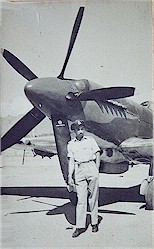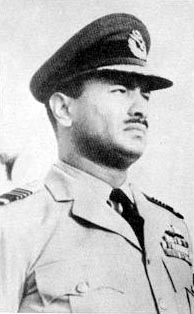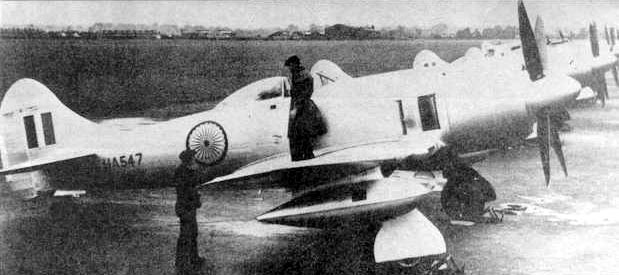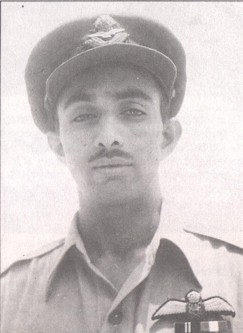The Air Force was never my choice for a career. I got into the Air Force after seeing my friends get into the armed forces during the Second World War. I wanted to practice Law, but fate led me to join the air force.
During my training at Hakimpet, One of my instructors was an Irishman, a Pilot Officer, he used to pull me and Idris Latif up to give us a rocket quite frequently. He used to say “Kuriyan, Latif, I know you are from different parts of India, speak different languages, but once you are in the Air Force, You are INDIANS! So forget which part you are from, which language you speak, what customs you do, you work as Indians!”. It was one lesson every air force man would learn, even today.
 |
| A newly commissioned Plt Offr V Kuriyan in his first photograph with an aircraft – A Spitfire XVIII from Ambala |
Immediately after being commissioned, I was posted to Kohat to join No.7 Squadron, then flying Spitfires. I reported to the station where the Adjutant asked me to meet the Squadron Commander in the Officers’ Mess. I went to the mess and found Sqn. Ldr. Madan Lal Mehra, the CO sitting by the bar along with another officer. I approached him.
“Acting Pilot Officer Verghese Kuriyan Reporting for duty. Sah!”
“At Ease, Pilot Officer” Said Madan “Join us for a drink?”
“Well.. A Glass of Orange Juice would do fine”
His eyebrows shot up. “Orange Juice! ORANGE JUICE!” He exclaimed. Then with a characteristic disapproving look, He turned to the bartender “Afzal, Give this ACTING PILOT OFFICER Kuriyan his glass of Orange Juice and ask him to BUGGER OFF!”
I stammered back. “Umm. Ahh! On second thoughts, A glass of whisky would do just fine. Sir.”
“Well, that’s more like it. Kuriyan.”
There and then, I started my induction into the world of alcohol.
I spent an year at Kohat, flying Spitfires on what was now routine training sorties. Some of my memories from those days include a Squash match I had with (Now Marshal) Arjan Singh. Arjan was the undisputed Squash Champion in the Indian Air Force. There was no one who could defeat him in that sport. He was amazed when I went upto him and asked to play a match with him. He was livid when I actually won the match! No one ever defeated Arjan Singh and this was a first. I dont think he forgave me for that match!
The Year 1947 bought with it the joy of expectations of Independent Nations. And also a sadness in the division of the Armed forces. It was now inevitable that the erstwhile Royal Indian Air Force will now be divided into two parts between the fledgling nations. In August, I was in Risalpur with the same squadron. We received orders asking us to hand over our Spitfires to the Pakistanis and await our transportation to India.
On August 14th, the Pakistan Independence Day, we had a roaring party in the Officers’ Mess. The Station Commander, a Wing Commander Janjua, started this with, “Tomorrow you are Indian Air Force, We are Pakistan Air Force, but today, we are still one. Lets drink to that, we are brothers!” And so it went and we all got drunk in the Mess in celebration.
The Next Day, 15th August 1947, we woke up groggily, got ready and made our way to the Officers Mess. There were six of us RIAF Officers, who at the Mess encountered Janjua at the entrance, with a nasty expression on his face.
He said “Gentlemen! The Officers Mess of the Pakistan Air Force is off limits to Indian PIGS”
We were taken aback. To be made persona non-grata overnight was something, but to be called a pig by a Muslim, whose religion thinks pigs are the lowest forms of life was something else. Janjua gave an ultimatum to pack our bags and leave the station and make our way back to India. Which was certain death at that time. So we stood there, Janjua with his menacing look blocking the entrance and we trying to make sense of how this situation has occurred. He was accompanied by two guards armed with Stens and the atmosphere was highly volatile.
Then all heads turned as a Bentley pulled up near the Officers Mess. Out stepped, Wg. Cdr. Asghar Khan, the senior-most officer of the PAF, immaculately dressed in his Khaki uniform. He walked over to the mess, and on seeing me called out,
“What’s happening George?”
Asghar Khan and my brother P.K. Kuriyan were both batch-mates at the IMA, when they took a transfer to the RIAF. Whenever my brother was visiting home from training, he used to get Asghar along as a guest. We knew Asghar Khan well enough to be on first name terms.
I replied, “Sir, We would prefer to killed right here on the airbase rather than be butchered on the way back in the trains.”
 |
Air Marshal Asghar Khan, later became CAS of the PAF |
Asghar Khan appeared perplexed. Then we explained our predicament. Asghar Khan blew his top off. He was enraged at the Pakistani Air Force Officer’s conduct. He took Janjua to task and gave him a ticking off of his life. I have never seen one officer being pulled up for something by his superior like this.
Asghar turned back to us and said “George, pack your bags. The IAF Dakotas will pick you up in six hours.” True to his word, a phone call and six hours later, Dakotas of the IAF came into evacuate the remaining IAF Personnel safely back to India.
We were stationed in Ambala, then re-equipped with the Hawker Tempest. An aircraft that was more powerful than the Spitfire. We were called up for action within days to counter the Tribal Invasion of Kashmir. We flew our Tempests to Srinagar in November.
Brigadier L.P. Sen was the Brigade Commander in the Valley at that point of time. He had just then routed an enemy column at Shalateng and had chased them all the way back to Uri. He could have chased them all the way to Domel Bridge, but was asked to relieve Punch instead. I was there when he pleaded with General Thimmayya on the phone to lend him two battalions so that he can pursue the enemy to Domel. The request was turned down. And an opportunity was lost.
|
|
The author of this article, then Flying Officer George Verghese Kuriyan of No.7 Squadron, RIAF. |
The author of this article, then Flying Officer George Verghese Kuriyan of No.7 Squadron, RIAF.
We were called upon to hit the Domel Bridge twice. I was leading one formation once and we attacked the bridge at a very low altitude. My bombs struck the bridge spot on, and I was elated to see it disappear in a cloud of dust. But my elation turned to dismay when I noticed the bridge was still standing. It was a very sturdy structure. Even my No.2’s bombs failed to bring down the bridge. I really appreciated the way it was built.
We then flew sorties to Kishenganga, Tithwal and even in Kargil, where the current fighting is going on. At Zoji La, a Maratha LI company was surprised by an ambush by the tribesmen as they sat down for their evening cup of tea. The troops retreated in disarray some leaving their weapons behind. We were called in to fly sorties to help Indian Troops recapture this lost position. And attacking targets on the mountains was an hair raising experience to say the least.

Tempest Fighters in 1947 in the early “Chakra” markings
Both me and my brother saw action in the Kashmir War. My brother, Major P.K. Kuriyan was with the 7th Light Cavalry and distinguished himself in action. He received the Vir Chakra award after the war. He retired as a Brigadier.
I was in Kashmir for over an year before No.7 Squadron moved out to re-quip with the Vampires. I was on the first batch of four pilots trained to fly these jet aircraft, then the first jets operated by any nation in Asia. We operated under Wg Cdr H Moolgavkar and were the first pilots to fly the Vampires in the IAF.
About the Author:
Wg. Cdr. Verghese Kuriyan was commissioned in the IAF just after WW2. A fighter pilot by choice, he saw action in the 1947-48 Kashmir Ops and was one of the first pilots to be trained on jets. He was the CO Flying of Pathankot Air Base during the ’65 war and under his guidance, Pathankot made a significant contribution in the operations. Wg. Cdr. Kuriyan took premature retirement after the ’65 War and worked with Kalinga Airways for some time. He has over 3000 hours of fighter aircraft flying and over 10,000 hours of Transport aircraft flying. The article is an excerpt from an interview with PVS Jagan Mohan in 1999.
